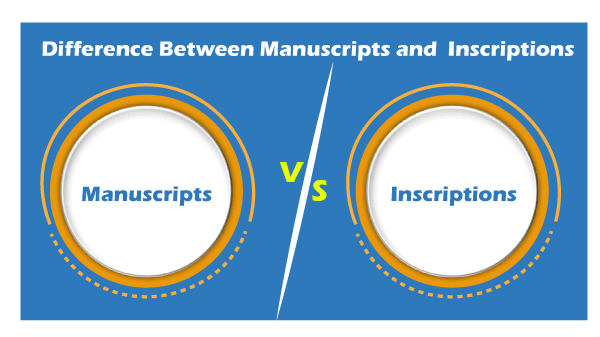Difference between Manuscripts and InscriptionsWe have heard about many autobiographies, biographies, manuscripts, etc. But still, there is a kind of doubt among all of us. All these terms appear to be the same, but they aren't. Manuscripts and inscription are the two most confusing terms. We often feel that the manuscript is a piece of art written before it actually came into being. The history of India has recorded many such manuscripts in their original form. However, only half of which were written has been retrieved by the archaeological department. Both manuscripts and inscriptions are a source of history. Students often read religious scriptures, which are a form of manuscripts and inscriptions. For instance, Ramayana, written by Rishi Valmiki, is a manuscript. Be it religious scriptures or any other form of historical account; they are regarded as manuscripts and inscriptions. The history of India is vivid and varied, and there are a lot of unspoken historical accounts that are regarded as manuscripts and inscriptions. Now, let us look at the basic meaning and the major contrasting points between them. 
ManuscriptsManuscripts are defined as the sources of historical knowledge that are written by hands. These accounts were generally written on the palm leaves. Manuscripts were used to record a particular piece of information that has happened in the past. Now, many of us relate manuscripts with prophecy. It is not so. Apart from Ramayana, everything that has been written or recorded has already happened in the past. Manuscripts were written so that the history of the period is preserved in the later periods. In the modern day, a manuscript is defined as a piece of art that has been written for the purpose of publishing. The piece of art is a creative work that has been written by hand instead of being typed. For instance, Ruskin Bond always writes by hand. So, the first copy that he gives for publishing can be labeled as a manuscript (i.e., the handwritten piece of work). Well, it is interesting to note that there are four significant types of manuscripts. They are original research, rapid communications, review articles, and case studies. InscriptionThe inscription is defined as an act of writing. The small piece of the inscription can be recorded on a stone or a leaf. Inscriptions are generally written to remember the meanings of a particular object/ thing. According to history, inscriptions are small pieces of information engraved on a stone or metal. Many historical pieces of evidence can be seen inscribed on such stones. For instance, a graveyard has many gravestones upon which the birth date and the date of death are inscribed along with one or two-liner poems. In the modern day, an inscription is considered as an autograph given by an author or a celebrity. It is the one or two sentences that are written on the front page of the books. Inscriptions are now called short messages that are given to people. Now, let us look at the major contrasting points between manuscripts and inscriptions.
So, these are some of the significant differences between manuscripts and inscriptions. Manuscripts are ancient pieces of information/ art, while inscriptions include ancient and modern day creative works. Now, let us look at some of the types of manuscripts and inscriptions. Types of Manuscripts
Types of inscriptionsThere are more than 100,000 inscriptions found in India. Some of them are listed below.
So, these are some of the significant types of inscriptions and manuscripts. There are many more unnamed inscriptions and manuscripts that are found in India and across the globe. Manuscripts are inscriptions are a source of knowledge to the present generation. Therefore, we must try and preserve them as much as we can.
Next TopicDifferences List
|
 For Videos Join Our Youtube Channel: Join Now
For Videos Join Our Youtube Channel: Join Now
Feedback
- Send your Feedback to [email protected]
Help Others, Please Share










